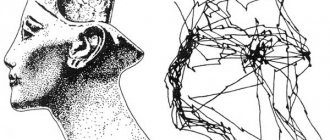This article is a general description of the laws of human memory and is the first of the subsection “Theoretical minimum” for the course “Effective teaching methods”. The article is intended for a reader unfamiliar with what neurons are, how they interact inside the brain, how human memory works, and why our brain likes to deceive itself.
What are neurons and how do they work in the brain?
Neuron - overview
The human brain is a very complex thing. To understand how memory works, you should know that the brain consists of neurons - small cells connected to each other using processes (axons and dendrites). In a simplified form, this can be compared to a web, only the spider weaves the web most often in the form of a plane, and the neurons connect in all directions!
The brain is a network of neurons connected in all directions
Spider web - a network of connected threads on a plane
The axon of one neuron joins the body, dendrites, or axon of another neuron. The point of contact between one neuron and another is called a synapse.
Schematic representation of a neuron and axonal processes connected to it from other neurons
There are many neurons in our brain—about 100 billion. In addition to the brain, neurons ensure the functioning of the entire body - from the head they convey information to the internal organs, muscles, and skin. The heart beats - the neurons tell it how often to do this. A feeling of hunger - these neurons received a signal about a lack of energy or certain elements in the body and “created” the desire to go eat. Are you reading a poem at the blackboard that you learned at home and can’t remember the line? The connection between the neurons turned out to be weak and they cannot restore the sequence of the information you loaded into the brain.
How do neurons communicate with each other?
Neurons are capable of transmitting information to each other using electricity. Every thought or action you make involves a chain of interconnected neurons through which an electrical impulse runs.
Electrical impulses between neurons
Each neuron is intertwined with approximately 10,000 other neurons. The stronger the neural connections, the better the functioning system of the whole organism is, we remember better, make decisions faster, and perform more accurate actions. Children have fewer connections, but they form faster, which is why it is much easier for a child to learn something new - his neurons have not yet formed stable connections.
The second factor influencing the efficiency of interaction between neurons is energy. Energy does not appear out of nowhere and does not disappear without a trace - this is one of the basic principles of our world! To transmit an electrical impulse to another neuron, you need to generate it. That is why up to 60% of a child’s total energy is spent on ensuring brain activity - the formation of stable neural connections requires a lot of energy. As we grow older, this figure decreases on average to 20%, but the brain still remains the most energy-consuming organ in the human body. The human body receives energy during the digestion of food and the subsequent delivery of the resulting elements to the cells of the body, including neurons. Therefore, for good learning, it is important to eat regularly and properly! (More details about the influence of nutrition on the learning process will be discussed in the 4th article of the “Theoretical Minimum”)
3D visualization of the brain, created by researchers from the University of California (USA). Glowing lines are excitable neurons that respond to signals coming from the external environment (what we hear, see, smell, etc.), as well as our thoughts.
Given the high energy consumption for the functioning of neurons, our brain tries to optimize all processes of interaction between them. Therefore, if the connection between neurons once formed is no longer used, after some time it disappears so that it can be used, if necessary, in another place.
Example : It is almost impossible to learn a poem by reading it just once. If you do not repeat it many times, the neural connections formed as a result of receiving information from the poem will soon weaken and disintegrate - even remembering the very fact of reading this verse will be problematic.
Memory test (spoiler)
During the lecture, about 15-20 minutes after the start, the students were asked to take a memory test, which consisted of two tasks. The first of which involved depicting the word “mind-blowing news” in the form of a picture, without using words or symbols. The second involved memorizing 10 words by ear, after two or three repetitions. The test, as expected, came at the very end of the lecture.
My results
Group results
It is noteworthy that, according to the lecturer, the picture is quite typical. A good result for the first word, a characteristic drop in the middle and in nouns that are rarely used and do not denote an object, and a slightly better result for memorizing the last words. The lecturer also noted that some of the words that were supposed to be memorized passed into long-term memory.
Channels of information perception
To remember something, the brain first needs to receive information (experience). A person receives information through six main senses:
- eyes (vision)
- ears (hearing),
- tongue (taste),
- nose (smell)
- skin (touch, sensation of pain, temperature).
- vestibular apparatus (sense of balance and position in space, acceleration, sensation of weight)
Schematic representation of the brain parts and their functions
We receive most of the educational information through the visual (eyes), auditory (hearing) and kinesthetic (movement, touch, balance) channels. At the same time, the ratio of the effectiveness of perception of these channels differs among different people - someone can look at a picture once and immediately remember it, someone will remember it better only if they hear a description of the picture, someone needs to touch it with their hands. Accordingly, people, based on their preferences for the channels of information they receive, can be divided into auditory, visual, and kinesthetic learners.
It should be understood that preference does not mean a lack of receptivity to other channels; they are also very important for building clear and easily reproducible memories/knowledge.
Through neurons, information from the sense organs travels to the brain, to other neurons that are involved in its evaluation, processing and storage.
Kinds
In psychology, different types of memory are distinguished, and the classifications are based on different reasons.
By the nature of mental activity:
- motor (motor);
- emotional;
- semantic (logical);
- figurative;
- auditory;
- taste;
- visual (sensory, visual, photographic, spatial);
- tactile;
- social;
- eidetic.
By the nature of goal setting:
- arbitrary;
- involuntary.
By duration of information storage:
- ultra-short-term (iconic and echoic);
- short-term;
- operational;
- long-term.
To organize memorization:
- episodic;
- procedural (automatic).
For information reproduction tools:
- a person’s own internal memory (the so-called “RAM”), when a person uses only personal storage data and internal resources;
- external (reproduction occurs using photographs, videos, reminders, i.e. using external resources).
We talked in more detail about each type and the classification available in psychology in a separate review.
Keep in mind. For early risers, mnemonic abilities are most effective from 8 am to noon, for night owls - from 8 pm to midnight. They should memorize the necessary information (learn poetry, prepare for exams or reports) during this time period.
Effect of hormones
How often the electric current passes between neurons and what the strength of this current is determined by the amount of special substances - neurotransmitter hormones. (mediator = intermediary)
Example : a store seller is an intermediary who transfers to us goods belonging to the store owner. Those. an intermediary is someone who transfers an object between two objects.
Hormones are produced in a special place in the brain, and by some internal organs in the body. In neurons, hormones are stored in synaptic vesicles.
To transmit information, neurons exchange the hormone Dopamine (D)
Schematic representation of a synapse - the junction between two neurons
Fear, joy, surprise - all these emotions are not only a manifestation of the brain’s reaction to external stimuli, but are also tied to the release of certain hormones into the space between neurons. If we like emotions, the brain associates the events associated with them with the production of the pleasure hormone and it becomes “interesting” or “pleasant” for us to perform actions that lead to the repeated release of this hormone.
Example : learning the multiplication table is boring and uninteresting, because the brain does not know the importance of this skill and does not release pleasure hormones into the blood. The numbers themselves are just symbols on paper; mental manipulation of these numbers is all the more difficult due to the lack of information support. Having assessed the energy costs and not finding a justification for them, the brain begins to interfere with the process of learning multiplication, which in its opinion is meaningless - we are constantly distracted by something, we begin to want to sleep, and get angry because of the “stupid numbers” flying out of our heads.
Multiplication table
At the same time, the process of playing on a computer is a much more visual source of information for the brain - there is sound and a changing picture. The movement of a character in a brain game feels like your own movements - all three main channels of information work!
Screenshot from the game The Witcher 3
In addition, when you complete a game level or perform actions in the game, you are given some kind of prize (experience, game items, currency) - for the brain this is a clear signal to produce a pleasure hormone, because the brain unconsciously does not understand that the skills acquired as a result of the game are most likely will not be useful, and things and game money are just pictures on the monitor that cannot be used in real life.
As a result, for the brain, the process of playing a computer game becomes very enjoyable and exciting, and the process of learning the multiplication table turns into painful cramming that gives you a headache.
Thus, the release of certain hormones is one of the brain’s ways to inhibit or excite neurons, depending on the decision it makes about the appropriateness of mental activity at the moment.
Basic memory processes
As part of the complex of abilities under consideration, it is customary to distinguish several main processes. They are discussed in detail below.
Memorization
This is the imprinting of perceived information, any acquired knowledge. A person becomes able to remember something after gaining experience interacting with certain objects and phenomena through sensations and perceptions. As a process, memorization can be voluntary and involuntary (analogy – voluntary and involuntary components of memory).
Preservation
This is holding something in memory. An example is training, when a student adopts the teacher’s manner of speaking and thinking and assimilates the information he offers. As a result of this operation, nerve connections are formed between cells, which literally line the nerve pathways - stored blocks of data.
Playback
This is the reconstruction of images that have been internalized and become stable, taking the form of templates thanks to the memorization and preservation of information about specific events. As a result of this process, previously formed neural connections are activated.
Forgetting
This is partial or complete erasing of specific fragments from memory. Memories associated with certain time periods, even long and important ones for the subject, are erased.
Some researchers link forgetting to the quality of retention of knowledge or patterns of experience.
Do you usually make a grocery list before going to the store?
Yes, because otherwise I might simply forget what I need to buy
25%
Only in case of a large purchase can I make a list
25%
I never make a list, I always focus on the spot
50%
Voted: 4
Consciousness, instincts and reflexes
In the example above, the word “unconsciously” is used. To explain it very simply, the unconscious part of our mind is all our thoughts and knowledge that we are not using at the moment.
Example : you don't think about how to breathe. You just breathe without even noticing it. Unconsciously, your brain commands the muscles of your chest and abdomen to contract in a special way, supporting the breathing process. But! You can stop breathing consciously, hold your breath, or vice versa - breathe in deeply, as much air as you can - this is your conscious (or conscious) decision.
In the unconscious part of our mind, many processes take place, entire chains of interactions between organs and various areas of the brain. A huge layer of our memory is stored there. If the brain perceives information or a sequence of actions as important, it forms neural connections in the unconscious part. When we first start learning to ride a bike or read, we need a lot of effort - to maintain balance, remember the name and meaning of words (because all this is done consciously, we control the process), but after some time we perform all these actions without thinking (we do not control the process, the unconscious part does this).
A chain of simple unconscious actions that is a reaction to a stimulus is called a reflex . Reflexes are divided into conditioned and unconditioned.
Unconditioned reflexes are innate actions necessary to provide the most basic needs of the body. Breathing, following a moving object with your eyes, blinking - all these are unconditioned reflexes.
Conditioned reflexes are chains of actions acquired as a result of interaction with the outside world. Riding a bicycle and the process of recognizing the meaning of a word while reading are conditioned reflexes.
In addition, humans have complexes of complex innate unconscious actions called instincts . Instincts include: the requirement to feel safe, hunger, the desire to sleep, procreation, curiosity. Some instincts begin to operate only from a certain age (for example, the instinct of procreation), some begin to weaken over time (with age, people become less curious, since the brain is already formed and does not need a lot of information), but such instincts as self-preservation, the requirement for sleep or hunger remain with a person almost all his life.
Are all people cyborgs?
Philosopher and scientist Andy Clarke believes that the human mind is always more than what “happens inside an ancient fortress of skin and skull.”
Clark blurs the boundaries between the "inner mind" and the "outer world" and argues that the human mind has always been externalized - extended outward.
The mind, according to Clark, is what is scattered in the things around us, external means of storing and retaining information, be it a paper notebook, a road sign, a store sign or a computer.
In this sense, we are all - no less than - cyborgs. And they always have been.
Clark rejects the idea of a separate “I”, but considers it promising not only to “expand outward”, but also inward, since “consciousness is <...> a huge, quiet cave of underground mental mechanisms, with its pipes, synapses and electrical impulses that form a pulsating substrate of the self. <…> When you think about all these fundamental mechanisms - ancient and shared with other mammals and distant ancestors <...> consciousness can seem like just a surface phenomenon, a user interface obscuring the real workings at lower levels.”
How does memory work?
So, we come to the most interesting part. Taking into account all of the above, it is worth building a diagram of how memory works and giving several illustrative examples.
Long-term and short-term memory
When receiving primary information from the senses or thinking about something, the brain forms an experience in short-term memory. This memory is temporary neural connections, their number is limited, so we cannot retain a lot of information in our minds at once. External factors can also influence the process of transferring information into short-term memory. Thus, there is a certain “filter” before information enters long-term memory.
Example : learning a poem when music is playing nearby at full volume is very problematic, since the auditory information channel interrupts the visual channel through which we read the words. Also, learning poems will not work during times of strong feelings or intense thoughts - if all thoughts are occupied with the upcoming party with friends, there is no room left for lines of poetry, they are recognized as insignificant and are not transferred to long-term memory. This is where the expression “lost a thought” comes from - the information located in short-term memory was recognized by the brain as unimportant and lost.
Next, this experience is analyzed, taking into account previously existing unconscious information (instincts and reflexes, previously acquired and remembered knowledge) and current conscious information (the thought “I need to learn a lesson, otherwise I will get a bad mark and my parents will argue”). Depending on the emotions experienced at the moment, hormones are activated that stimulate the brain to absorb incoming primary information more actively or slow down its flow, trying to switch attention and interrupt the process of absorbing “unnecessary” information (pleasure from the process of a computer game or irritation from the difficulty of learning the multiplication table).
Information is stored in short-term memory for 20-30 seconds, then the brain makes a decision to transfer the information to long-term memory . If the transfer of experience from short-term memory does not occur, it disappears (temporary neural connections are broken) and we no longer remember this experience. Several factors influence whether information will be transferred to long-term memory:
- repeatability
- involvement
- power of perception
- preliminary experience in long-term memory
- sufficiency of energy
General diagram of the process of processing information and storing it With repetition , everything is simple - we “pound” the brain with the same information, it decides that each time it is too energy-consuming to perceive and process this information and stores it in long-term memory.
Engagement depends on emotions that are tied to the release of hormones. The process of a computer game evokes positive emotions in us - we get carried away with the game and can sit at it for hours, while studying homework (without realizing the importance of the process!) is easily interrupted by the desire to check our page on a social network or phone to see if something has arrived messages.
The strength of perception is the intensity of incoming information. Volume, brightness, pain, number of information channels - all this forms the overall level of perceptual strength. Just a bright flash on a monitor screen without sound and the same bright flash with a loud bang are perceived and remembered completely differently (to check, try playing two unfamiliar video clips of the same artist on YouTube, but while familiarizing yourself with one of them, turn off the sound, and then try describe these clips).
Prior experience in long-term memory is the most important factor! The need to save energy forces the brain to connect neural connections with new information to existing connections, the neurons of which processed similar information in the past. Information that is too complex, the basic concepts of which are not in long-term memory, will either not be absorbed by the brain, or will be stored without connections with other neurons. Even after “memorizing” such complex information that is not related to previous experience, you will not be able to quickly extract it into short-term memory in order to apply it when processing new information. Therefore, at school, they first study addition/multiplication, and only at the end of training do logarithms and integrals begin - without basic mathematical knowledge, it is almost impossible to use complex terms and constructions.
Sufficient energy allows the brain to allocate the necessary amount of its power to process information. If we really want to eat or sleep, all thoughts will be only about this, and attempts to learn something will be interrupted by a growling stomach or “sticky” eyes.
Properties
Human memory has certain properties on which its quality and volume depend.
Absent-mindedness
If attention is focused on one thing, recording and reproducing information on a topic that is not of interest will be impossible.
Examples. The driver is in a hurry on the road, the weather conditions are bad, the emergency situation has increased, he tries to maneuver in such a way as to avoid an accident and get to the appointed place at the appointed time. At that moment someone calls him. Most likely, after he hangs up, he won’t even remember who called him and what they said.
Helpful advice. At moments when maximum concentration of attention is required, you cannot be distracted by other events and emotions, much less set yourself the goal of remembering information that is not relevant at that time.
On the tip of the tongue
This property most often manifests itself in older people, although almost everyone was hostage to such a situation. When one of the synaptic bridges is not used for a long time, neural connections weaken. It does not disappear, but seems to be stored under a layer of snow. When it is necessary to reproduce information associated with it, neurons look for it, but do not find it immediately.
In practice, it looks like this: we know exactly the last name and first name of a given writer, but we just can’t remember. Often the opposite situation arises: you’ve already heard this word somewhere, but you can’t remember where exactly.
Helpful advice. Associations will become a router for finding synaptic bridges “under the snow” - master mnemonics.
Sleeper effect
It is human nature to often make mistakes about the source of the information he has. We think we know this term because we learned it during our student days from a textbook, the accuracy of which no one doubts. In fact, it turns out that they heard it briefly on TV, and besides, the accuracy of the wording left much to be desired.
Helpful advice. Double-check information that relates to long-term memory.
False memories
If all the people who are eyewitnesses to the same event say that something happened that actually did not happen, the person will repeat the same thing after them in 90% of cases. At the same time, he will be sure that this really took place, he just forgot the details.
Helpful advice. Learn to trust yourself and not follow the crowd just because everyone says so.
Stereotypical consciousness
Memory adapts to the stereotypes of human consciousness. If the cult of the female figure “90-60-90” is popular in modern society, men remember girls with this particular physique better. The racist will be sure that the crime was committed by a man of the Negroid race and will even go as a witness that he himself saw it, although in reality nothing happened.
Helpful advice. Develop self-awareness, free from the framework, conventions and stereotypes of society.
Forgetfulness curve
Everyone dreams of having a phenomenal memory and remembering to the smallest detail the events of long-ago days. Many people get upset when they can’t remember the name of their deskmate in 1st grade. In fact, the brain is an incredibly smart device, and it simply erases information that is not only outdated and never reproduced, but also completely useless.
Helpful advice. Don’t be upset if some moments from the past are forgotten forever: it means that the brain considered them useless.
Reconsolidation
Under the influence of emotional and stress factors, the process of recording information occurs much faster and with better quality. That is why a person so often reproduces unpleasant moments - quarrels, conversations with the boss, humiliation.
Helpful advice. In order not to further traumatize your memory and not to clutter it with unnecessary and unpleasant information, try by any means to strengthen your nervous system and avoid traumatic situations.
Infantile amnesia
Guinea pigs remember everything they have been taught since birth. Human memory does not have this property. We reproduce only information that was received after 3 years. Psychologists still cannot find an explanation for this phenomenon.
Helpful advice. You can only come to terms with this. Or become a guinea pig.
Flashes
Sometimes a person remembers an event as vividly as possible: a wedding, a funeral, a trip. 5 years pass, 10, 20, and the memories remain just as clear and detailed. Unfortunately, this is a false picture. As studies have shown, 50% of information turns out to be incorrect, as it is embellished and made up at the time of reproduction.
Helpful advice. Try to avoid such outbursts. The less frequently you retrieve such information from storage, the more accurately you save it.
Obsessiveness
Sometimes it is difficult to free yourself from the obsessive memories that follow you: every now and then a divorce, a dismissal, or some offensive words come up in your memory. They can lead to depression and even suicide. This is evidence of psychological trauma.
Helpful advice. In such cases, you should definitely contact a psychologist. It is extremely difficult to free yourself from obsessive memories.
Psychologists and psychotherapists actively use all these properties of human memory in their work to help individuals overcome internal crises and get rid of traumatic moments forever. In ordinary life, knowing about them, you can do it yourself, taking into account the advice that was given for each of the features.
With the world - one by one. Scientists from Los Angeles claim that very soon it will be possible to transfer memories from one brain to another using RNA molecules. If you wanted to share your impressions and experiences with someone, you don’t have to tell them: your interlocutor will be able to experience them himself.
Questions for self-control
As we found out above, one of the factors in consolidating information in memory is its repetition. The speed and efficiency of extracting information from the unconscious part is also influenced by the fact of independent reproduction of information without referring to its original source. Answer the questions listed below (you can orally, but it’s better in writing - this will use fine motor skills and memorization will be more effective) to consolidate the entire topic:
Answer the questions - make the elephant happy!
- What are neurons and how do they communicate with each other?
- What are the main channels of information perception called?
- How do hormones affect the memory process?
- What are unconscious actions?
- What are conditioned and unconditioned reflexes? Instincts?
- What is long-term and short-term memory?
- What factors influence the transfer of information from short-term to long-term memory?
This section is under development! You can help the process by completing a short survey:
How do you like the article? You can select several answer options or add your own.
Individual differences in memory in humans
Differences in memory can be explained by what type of memory is used most often. They are also influenced by the nature of the work performed and the characteristics of daily activities.
A striking example is researchers. They have developed semantic and logical types of memory, while the level of development of mechanical memory suffers.
All processes associated with memory, in particular the speed of memorization, as well as the speed of reproduction, which is important to understand, are influenced by personal characteristics, mood, interests and desires. The combination of these and other factors determines individual differences. They can also be explained by how emotionally significant this or that event is for a particular subject, what his state is at the moment of receiving the experience.










